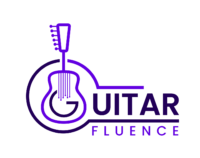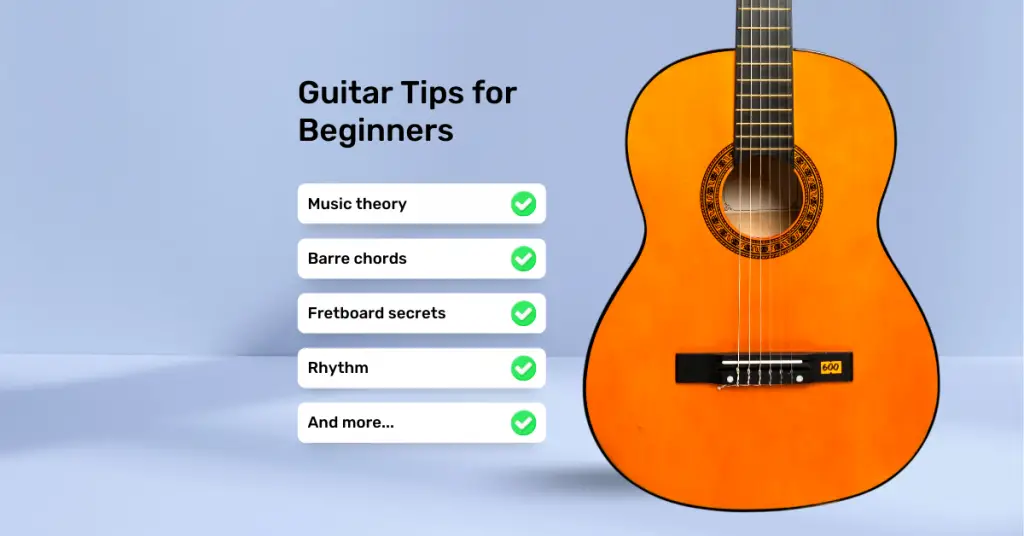Learn the essential guitar chords you must know. From basic open chords to your first 7th chords, these chords unlock 1000’s of songs on the guitar.
In this lesson you’ll learn the 8 guitar chords you must know, plus 5 more chords to help you play your favorite songs and expand your chord knowledge.
This comprehensive guide covers everything from basic open chords to barre chords for beginner guitarists, so you can take your guitar playing to new heights!
As a whole, there are 8 guitar chords you must know in order to understand the fretboard. They are:
- C Major
- A Major
- G Major
- E Major
- D Major
- A Minor
- D Minor
- E Minor
These are called the CAGED shapes. This is due to the fact that the chords C+A+G+E+D spell out the name CAGED. From there, you have to remember the 3 minor CAGED chords, which are A minor, D minor, and E minor.
These 8 shapes are not only useful as open guitar chords, but they’re also movable chord shapes.
There are 5 more that guitar chords that are essential, and derived from these shapes:
- F Chord (the F barre Shape)
- B Minor
- D7 (The V in G)
- G7 (The V in C)
- A7 (The V in D)
Most of these chords are open chord shapes.
C Major
How to play the C Major Chord: To play the C major chord on guitar, simply place your third finger on the third fret of the A string, your second finger on the second fret of the D string, and your first finger on the first fret of the B string.
Only strum from the bottom five strings, strings A-high E, because the low E will interfere with the C bass note on the A string.

If you’re a guitar player of any kind, learning the C major chord is a must. It’s one of the first chords that new guitar players learn, and for good reason.
It’s not only easy to play, but it’s also versatile and appears in countless songs across genres.
Learn the C Major chord in-depth
A Major
How to play the A Major Chord: To play the A major chord, place your second finger on the second fret of the D string, your third finger on the second fret of the G string, and your fourth finger on the second fret of the B string.
Leave the A string and high e string open.
Strum strings A through high e to play the full chord. You can incorporate the low E, but it’s not typical, and can take away from the A chord’s rich sound depending on the musical context.
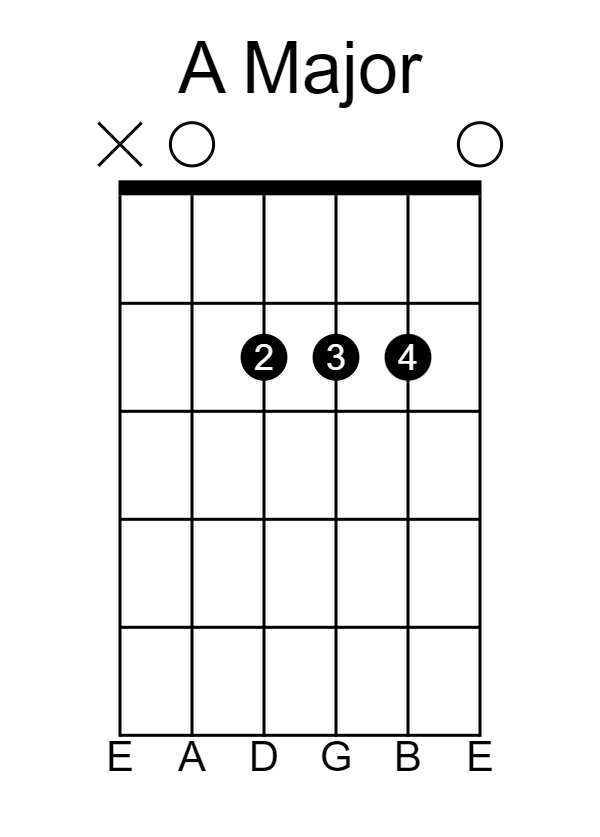
Once again, the A major chord is an incredibly versatile chord that can be used in a wide variety of songs and styles, from rock and pop to country and folk.
Learn the A Major chord in-depth
G Major
How to play the G Major Chord: To play the open G major shape put your third finger on the third fret of the low E string, your second finger on the second fret of the A string, and end with your fourth finger on the third fret of the high e string.
Leave the D,G, and B strings open, then strum all six strings.
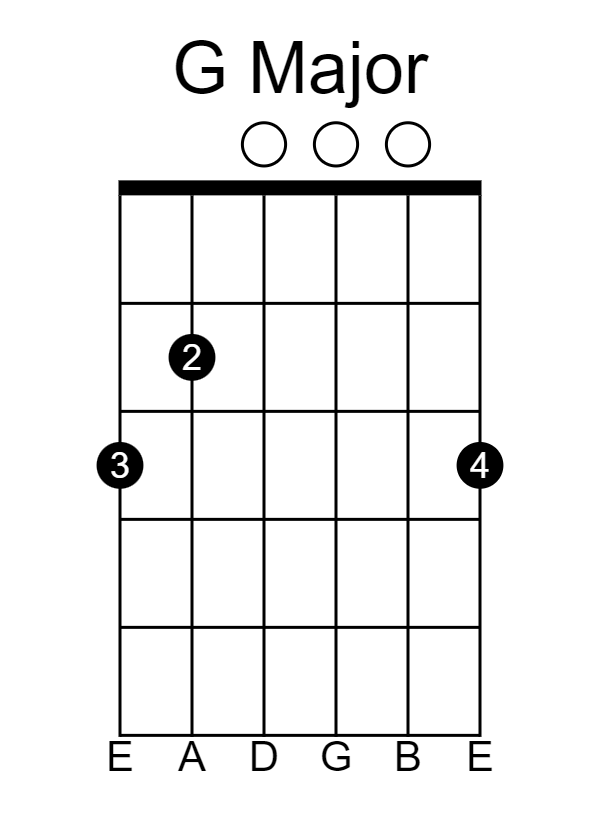
If you’re just starting out learning the guitar, one of the first chords you must learn is the G major chord. It pairs well with E minor, and it’s a staple in loads of popular songs.
Learn the G Major chord in-depth
E Major
How to play the E Major Chord: To play an E major chord on the guitar, place your second finger on the second fret of the A string, your third finger on the second fret of the D string, and your first finger on the first fret of the G string.
Don’t forget to strum all six strings to get the complete sound!
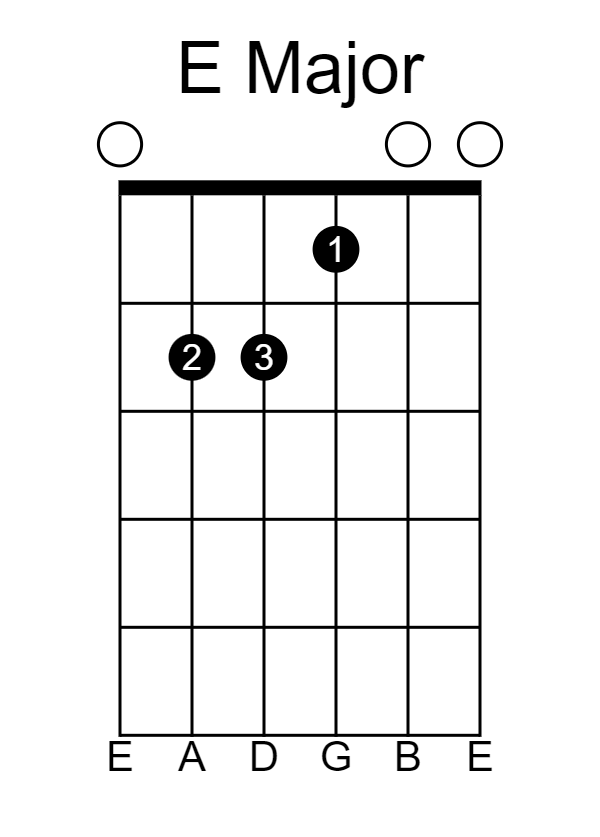
The E major chord is one of my favorite guitar chords ever. It’s a staple in countless songs across different genres and can add variety and flavor to your playing.
Learn the E Major chord in-depth
D Major
How to play the D Major Chord: To play D major, place your second finger on the second fret of the high e string, your third finger on the third fret of the B string, and your first finger on the second fret of the G string.
Strum the bottom four strings from there to complete the D major chord.
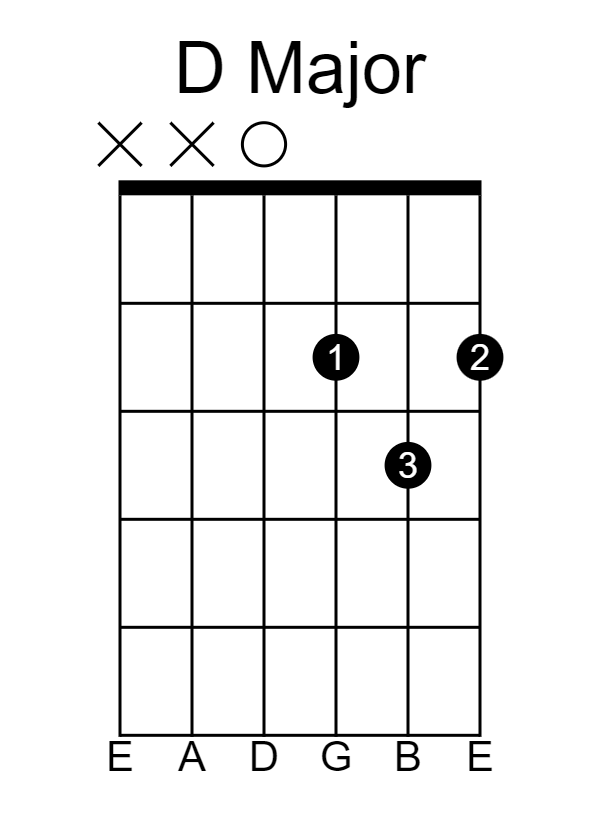
The D major guitar chord is a must-know for any beginner guitarist.
It is one of the simplest chords to play as it only requires three fingers placed on the three highest strings.
Not only is it easy to play but it also has a warm and bright sound that makes it a common contender for strumming along to folk or country songs.
Learn the D Major chord in-depth
A Minor
How to play the A Minor Chord: To play the A minor chord, you need to place your second finger on the second fret of the D string, your third finger on the second fret of the G string, and your first finger on the first fret of the B string to finish.
Strum strings A- high E to play the chord, and try not to hit the low E string.
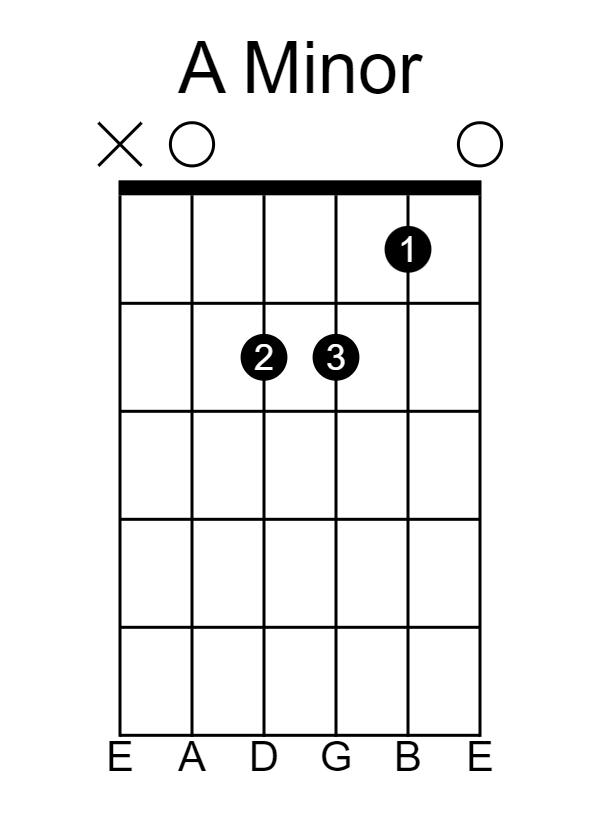
One minor guitar chord that should be on every beginner’s radar is the A minor chord.
This particular chord is often used in various genres such as rock, blues, and pop music.
Learn the A Minor chord in-depth
D Minor
How to play the D Minor Chord: To play the D minor chord, you need to place your second finger on the second fret of the G string, your third finger on the third fret of the B string, and your first finger on the first fret of the high E string to finish.
Strum the bottom four strings of the guitar to play the whole D minor chord. You can also incorporate the open A string.
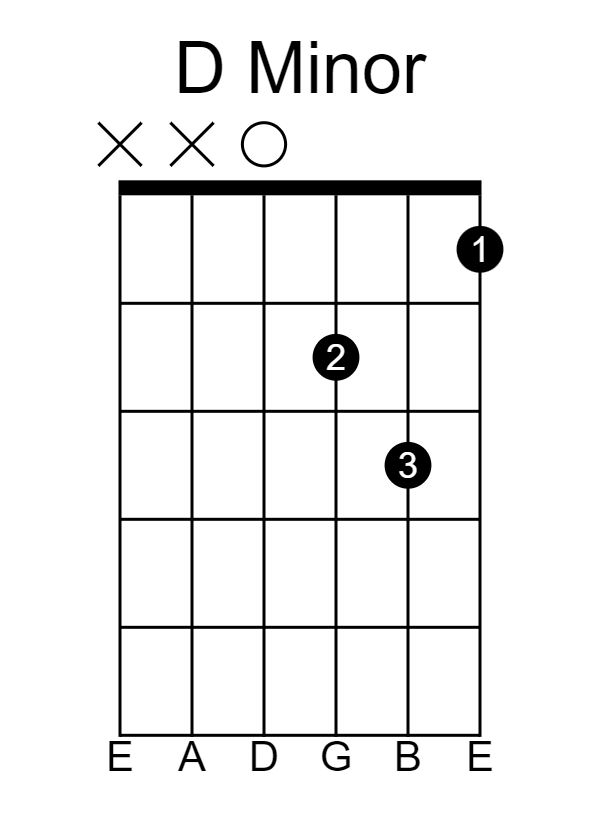
The D minor chord is the bass triad for the saddest key in music, D minor.
It’s also the chord I find beginner guitar players tend to forget. I think this is due to its odd chord shape.
Once you get down the D minor chord shape, you’ll have an easier time transitioning between other chords like G major and A minor.
Learn the D Minor chord in-depth
E Minor
How to play the E Minor Chord: To play the E minor chord, place your second finger on the second fret of the A string, your third finger on the second fret of the D string, then strum all 6 guitar strings.

The E minor chord is likely one of of the first guitar chords you’ll ever learn. It’s stupidly easy to play, and it’s used in plenty of songs that you know.
Seek out and learn some songs using the E minor chord once you’ve learned how to play it.
Learn the E Minor chord in-depth
F Major
How to play the F Major Chord: To play the F major chord, place your third finger on the third fret of the D string, your second finger on the second fret of the G string, barre your first finger on the first fret of strings B and high E, then strum the bottom four guitar strings.

The F chord is the 4 chord in the 1 4 5 chord progression in the key of C major.
And no, the F chord isn’t fun for beginners, and not really for advanced players either. This is due to the pesky barre being played at the 1st fret. Trust me, there are a lot of easier barre chords.
Here are some easier ways to the F major chord on guitar if you want to check them out.
B Minor
How to play the B Minor Chord: To play the B minor chord, place your first finger on the second fret of the A string, your third finger on the fourth fret of the D string, your fourth finger on the fourth fret of the G string, your second finger on the third fret of the B string, and barre your first finger on the first fret of the high E string. The barre is optional.
Strum the bottom five strings of the guitar to play B minor, or the middle four strings if you don’t want to use a barre.
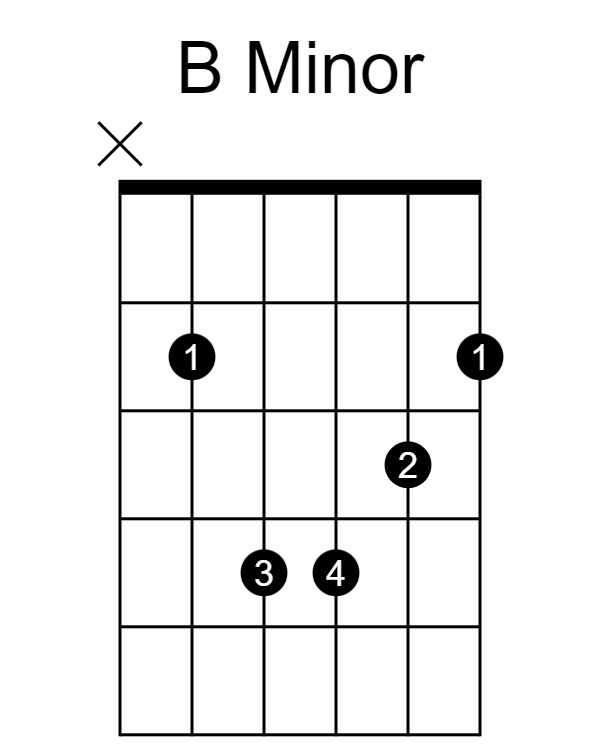
The B minor chord is based on an A minor chord shape. You can see this by looking at the shape made on the D, G, and B strings.
Its one of the chords you must know, especially if you’re looking to expand your skills and repertoire. It’s often used in rock guitar, in songs such as Kryptonite by 3 Doors Down, but you’ll find it in other genres as well.
The B minor chord will take some practice, but it will prove to be useful as you learn more chords and chord progressions.
Learn the B Minor chord in-depth
G7
How to play the G7 Chord: To play an open G7 chord, place your first finger on the 1st fret of the high e string, second finger on the 2nd fret of the A string, and third finger on the 3rd fret of the low E string.
Make sure all six strings are properly pressed down and strum away!

G7 is one of the most important dominant 7th chords you must know.
Practice transitioning between the G7 chord and other commonly used chords like open C and open D to get comfortable with applying it.
D7
How to play the D7 Chord: To play the D7 chord, place your third finger on the second fret of the high e string, your first finger on the first fret of the B string, and your second finger on the second fret of the G string.
Then strum the bottom four strings of the guitar, from D to high e, and you will have played the D7 chord!
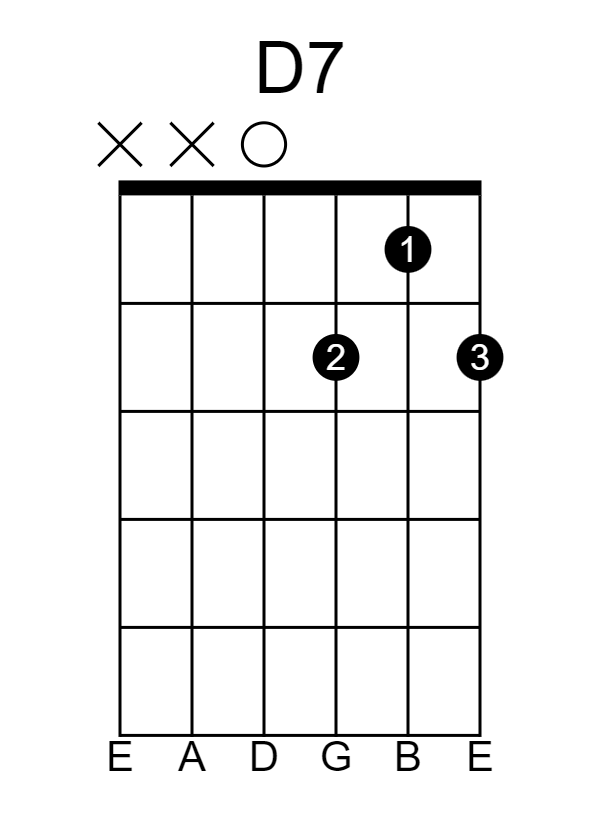
The D7 guitar chord is one of the most common guitar chords for beginners and is one of the first guitar chords that I teach to most of my guitar students below the age of 10.
Because it is the V chord in the key of G major, it is quite common in Western music.
A7
How to play the A7 Chord: To play the A7 chord you’ll place your fourth finger on the second fret of the B string, and your second finger on the second fret of the D string.
Then you will strum strings A through high e, giving you a complete A dominant 7th chord.
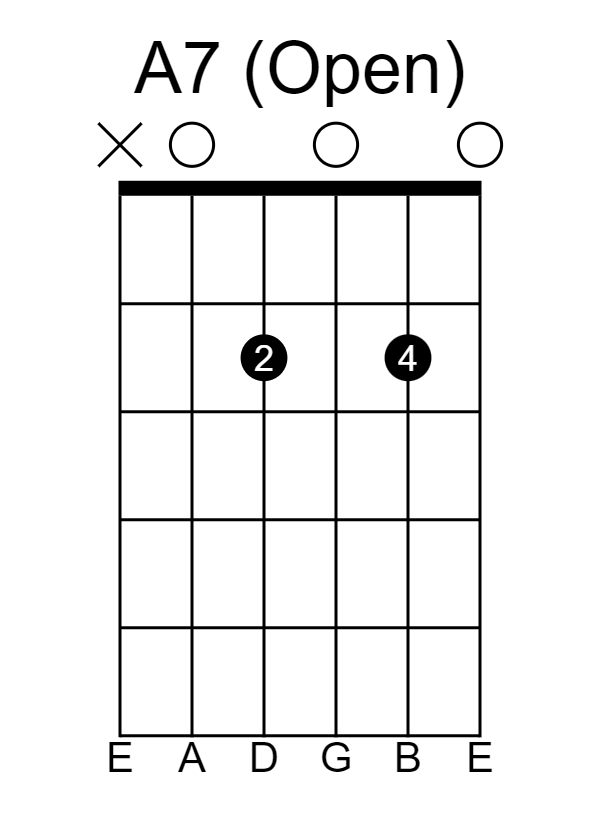
The A7 chord is just like an A major chord, but you remove your ring finger which gives you an open G string.
This chord is often used as the V chord in the key of D major and is a fun alternative to your standard open A major chord.
Chords you must know conclusion
There you have it! Those are the 8 guitar chords you must know, plus 5 more important ones based on the 8 CAGED shapes, and used regularly in popular music.
Most of them are open chords, and will be your bread and butter if you’re an acoustic guitar player.
Check out my post about the most beautiful guitar chords if you want to further expand your chord vocabulary.
And check out my guitar lessons YouTube channel for guitar video lessons!
Rock on.
